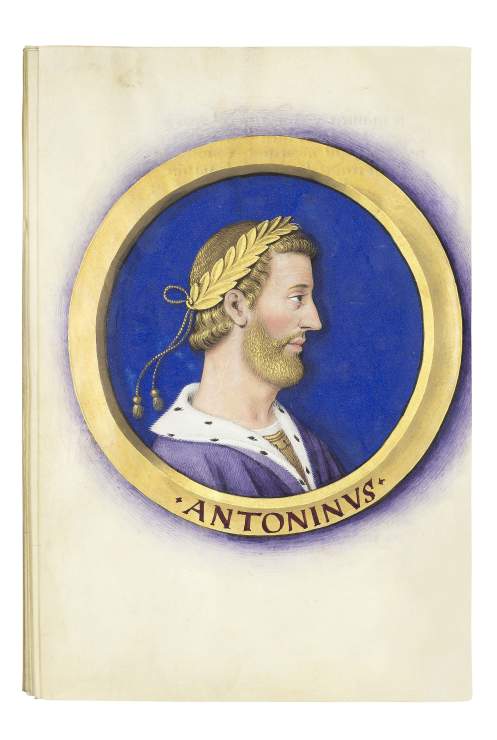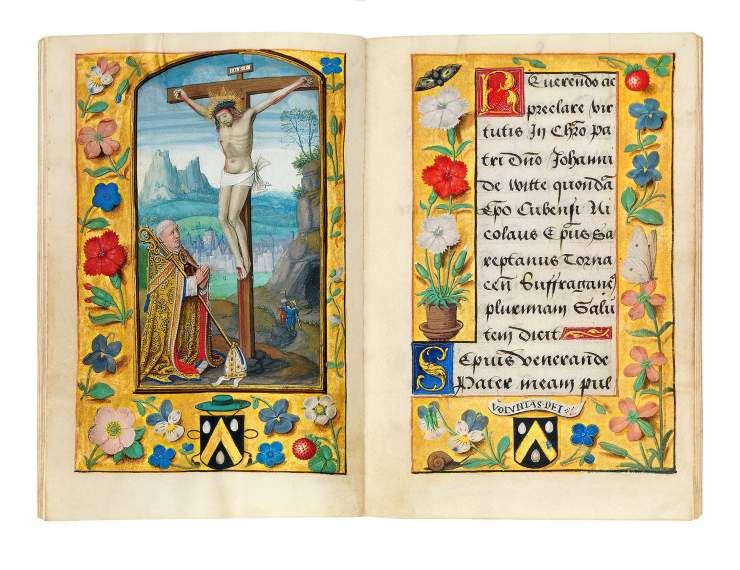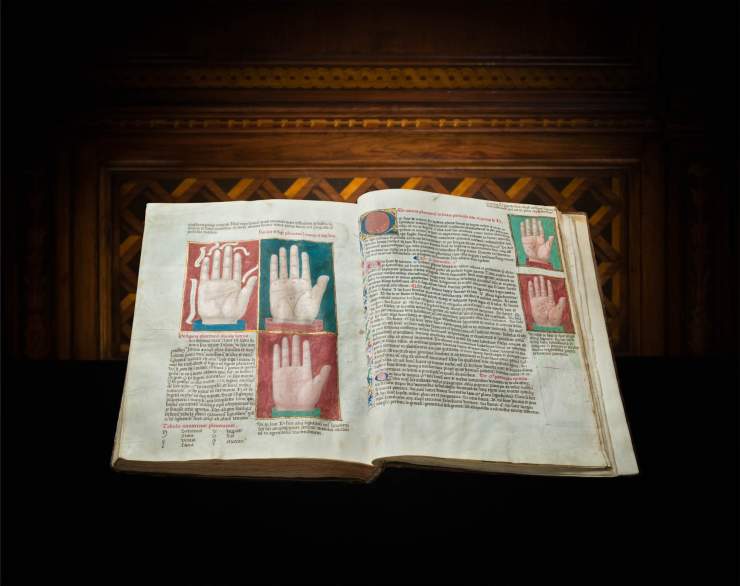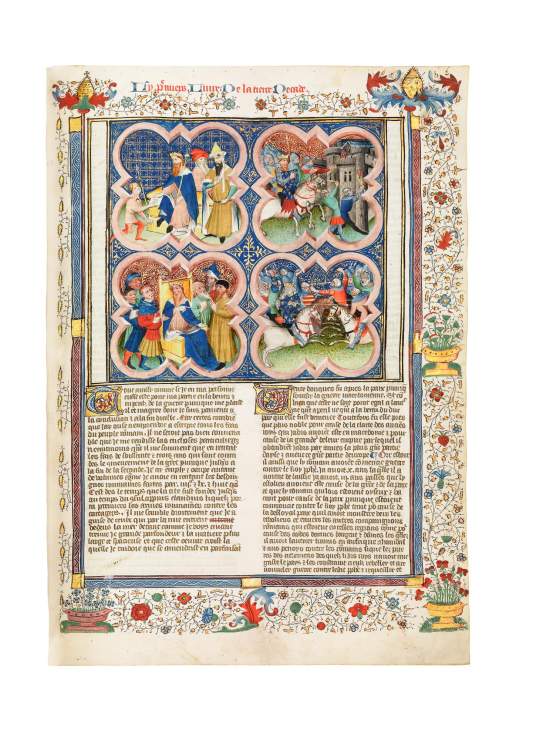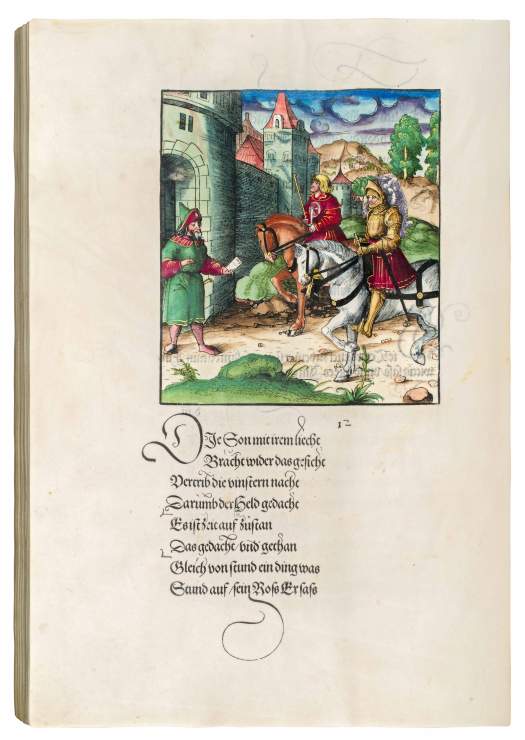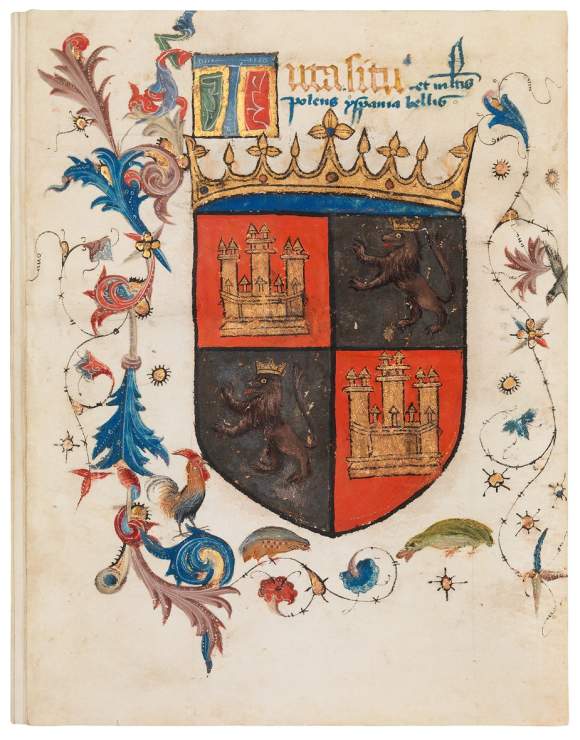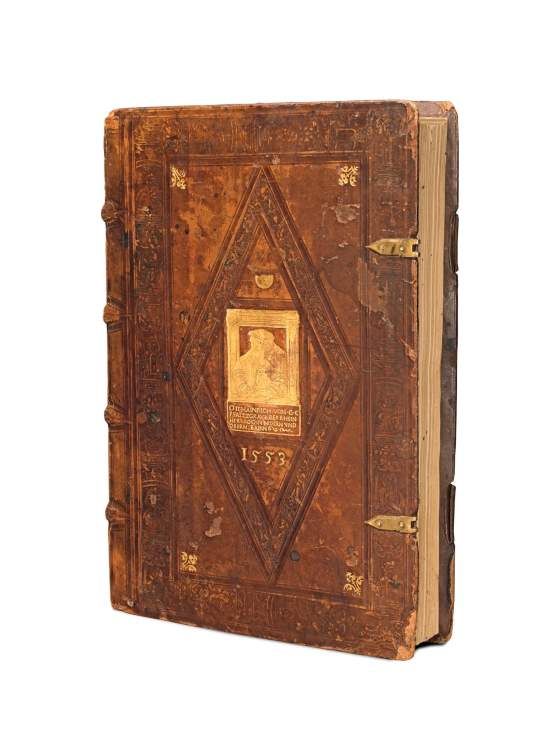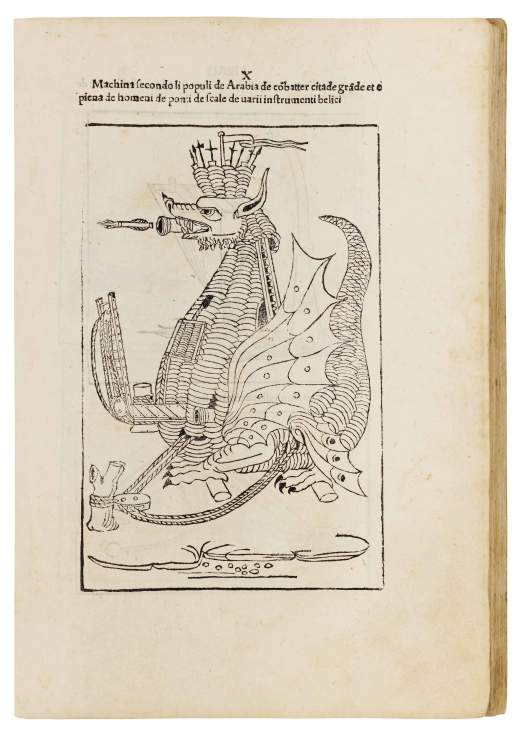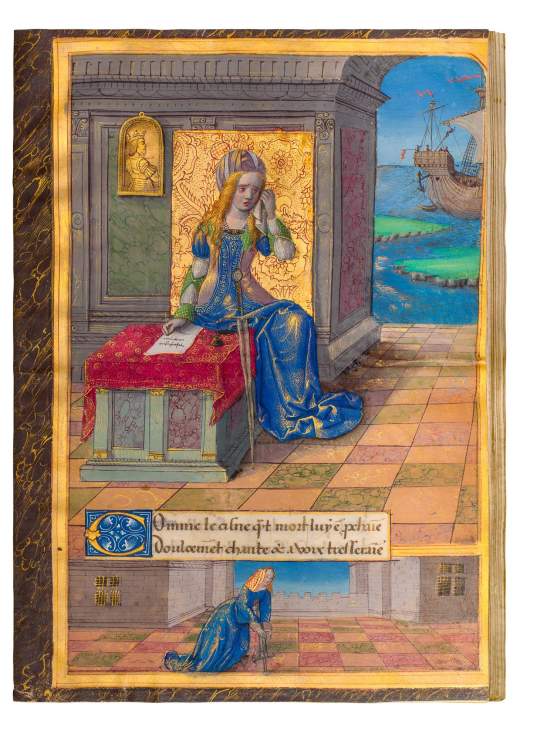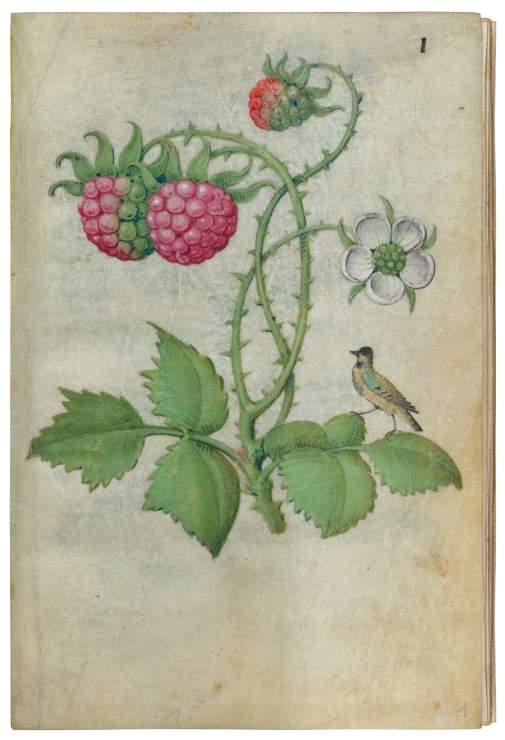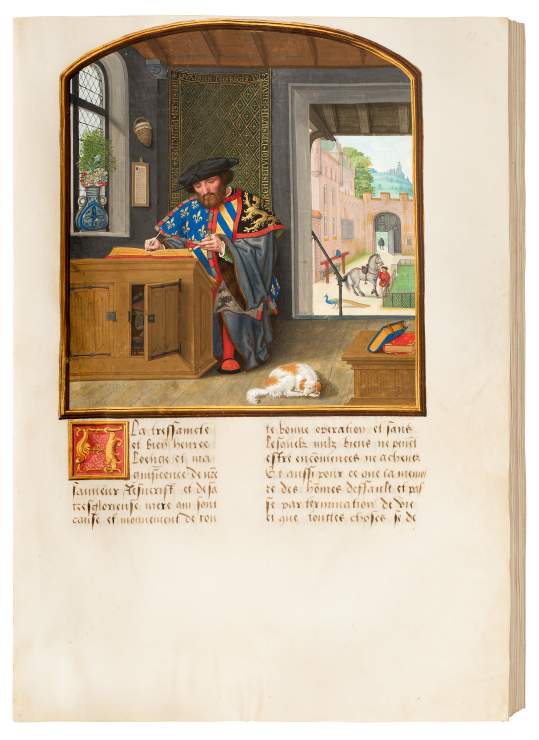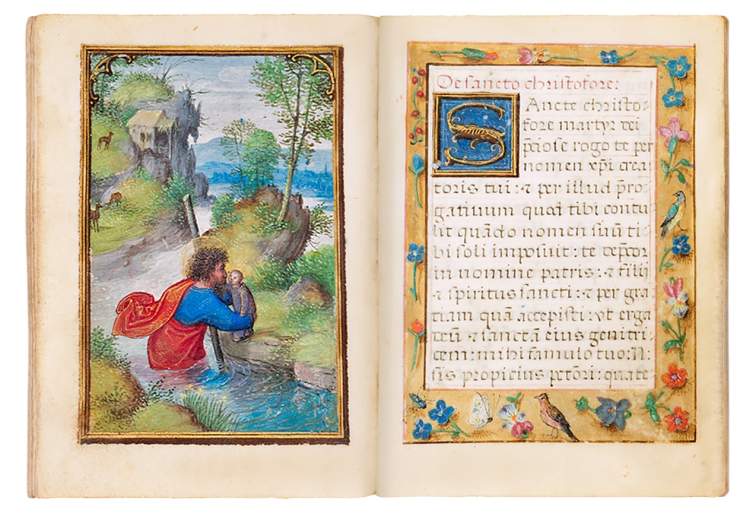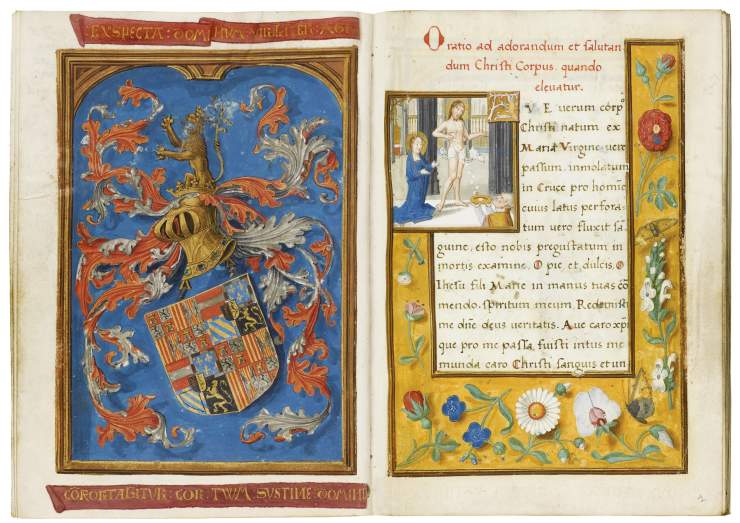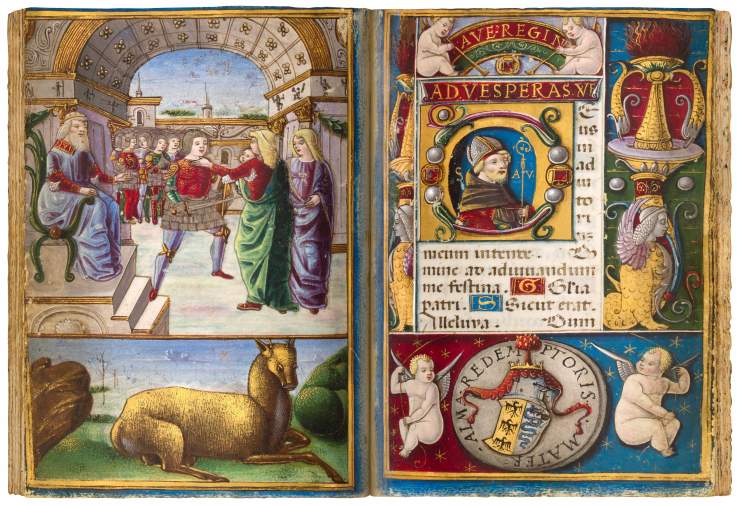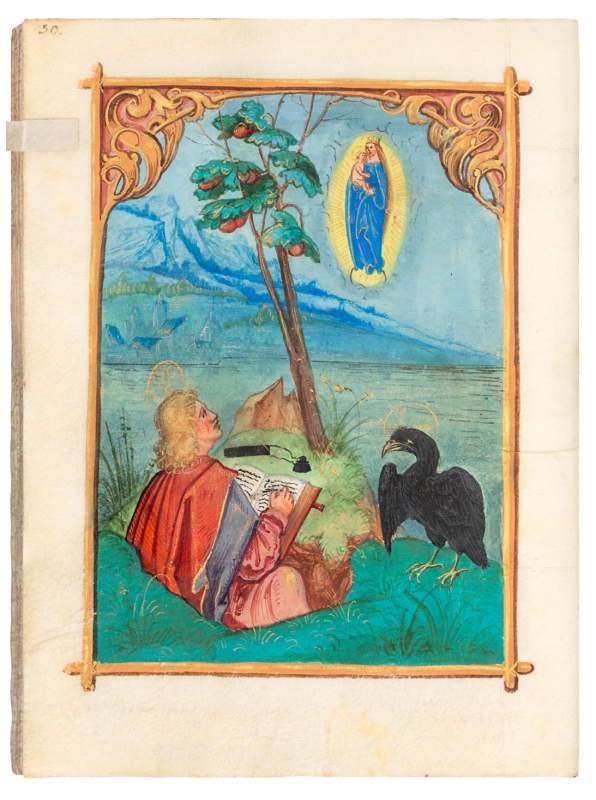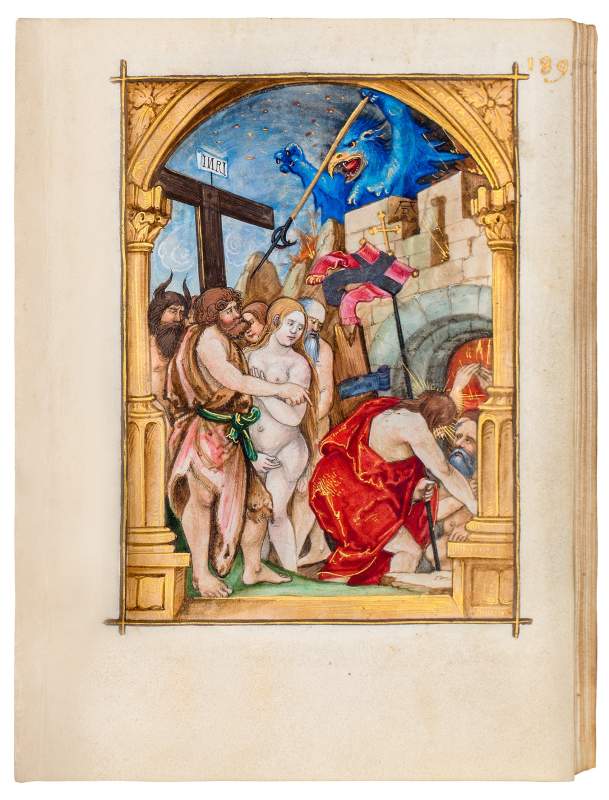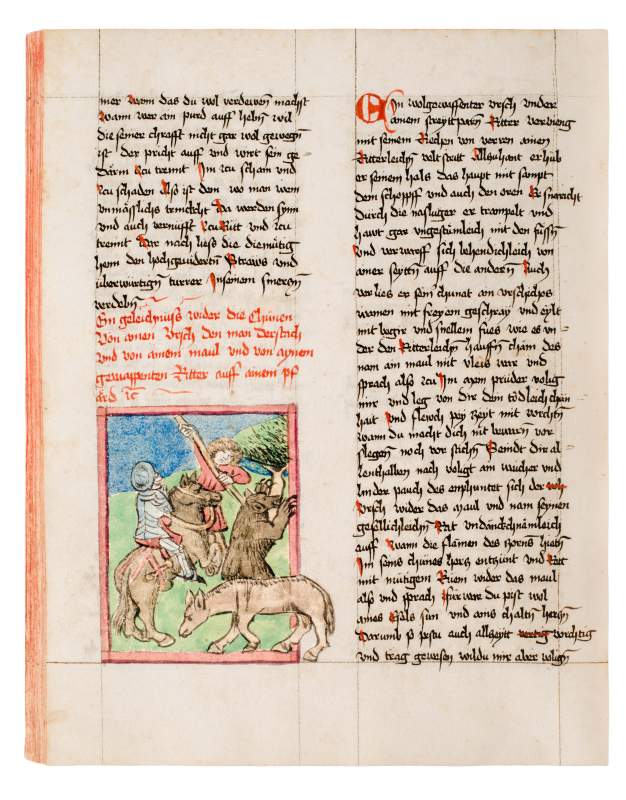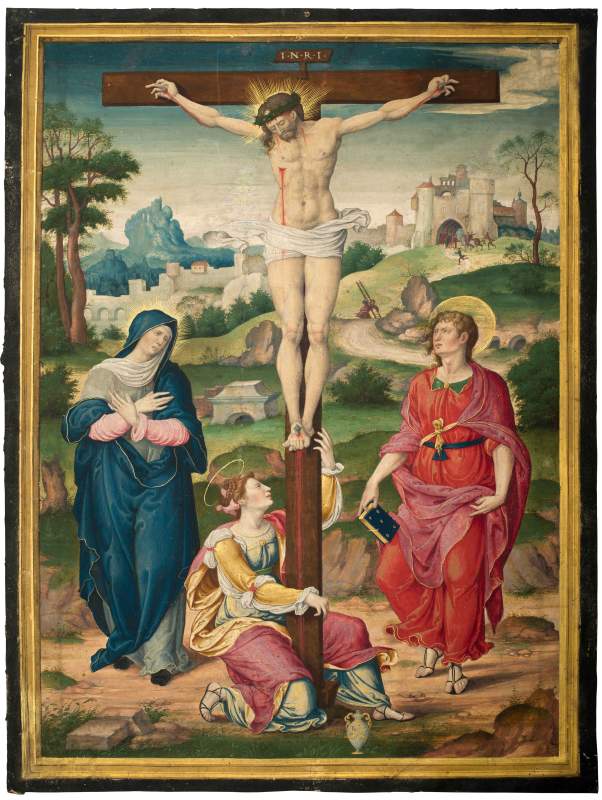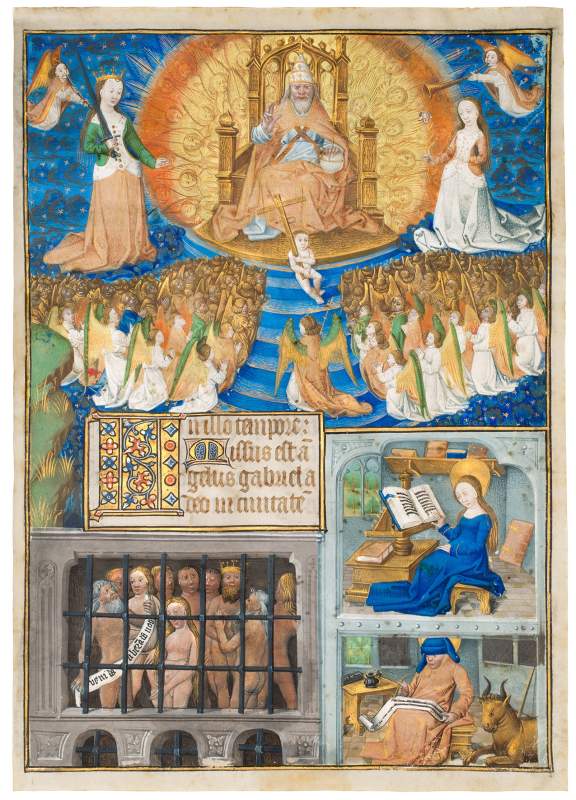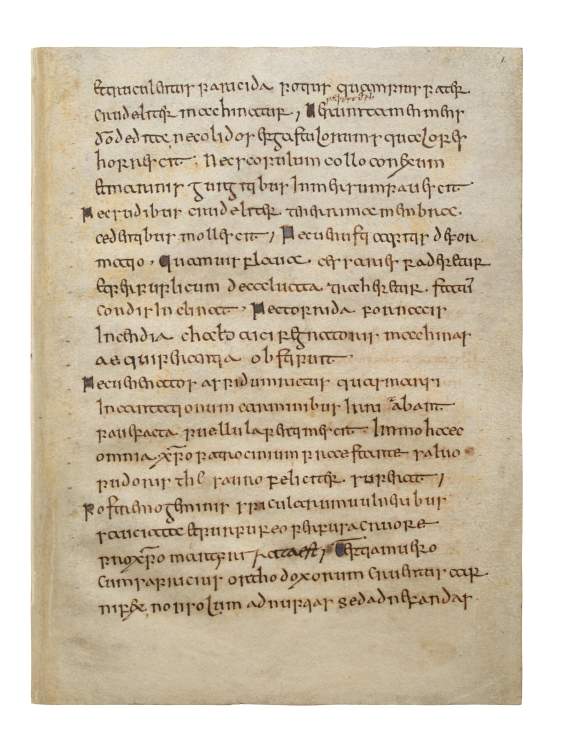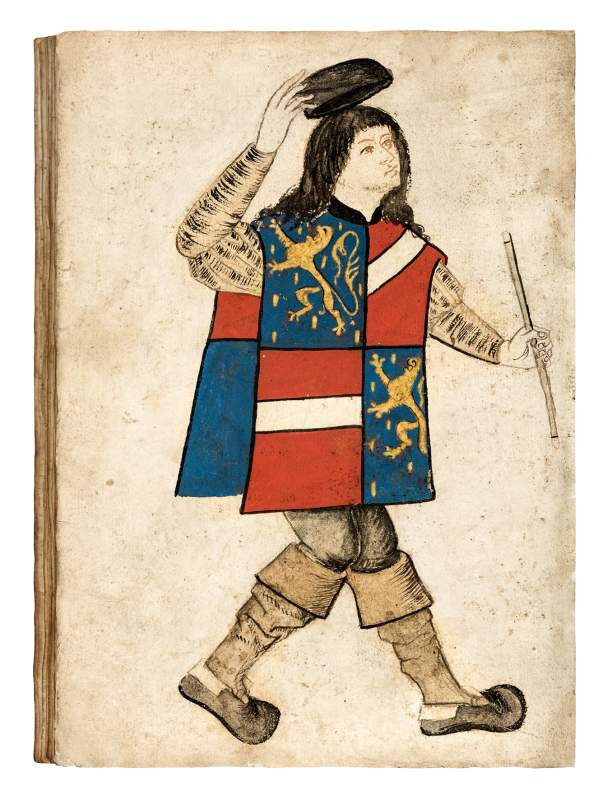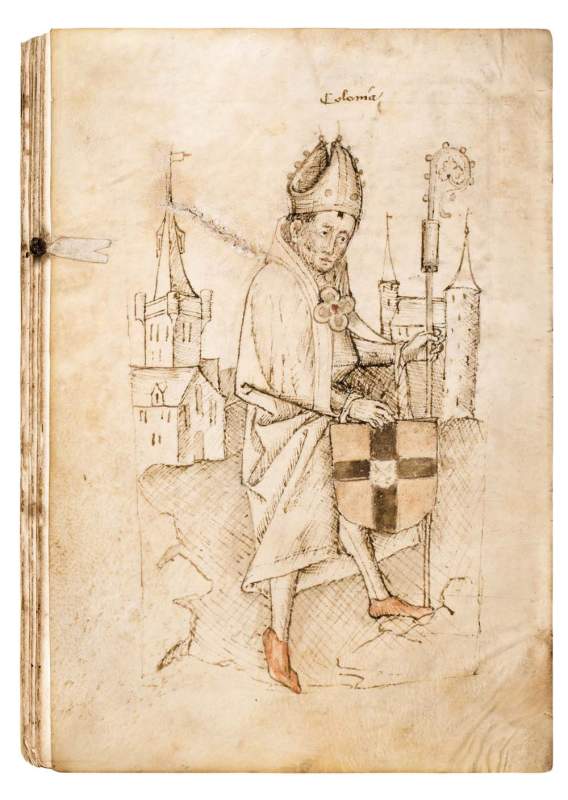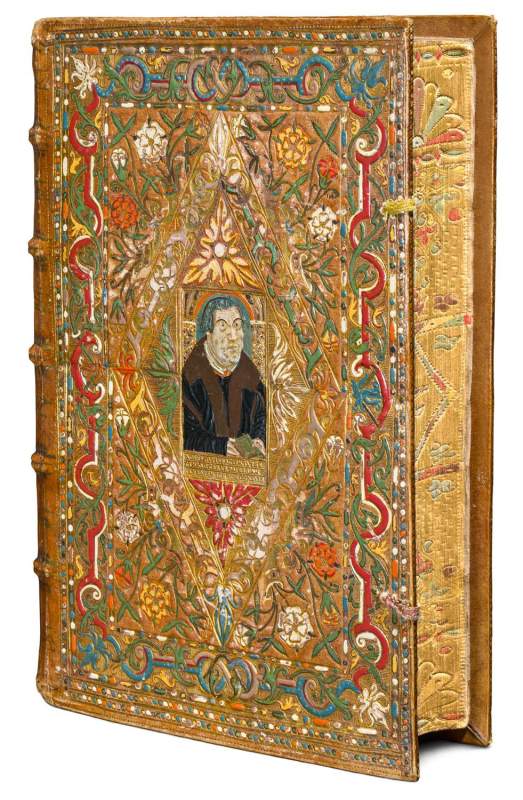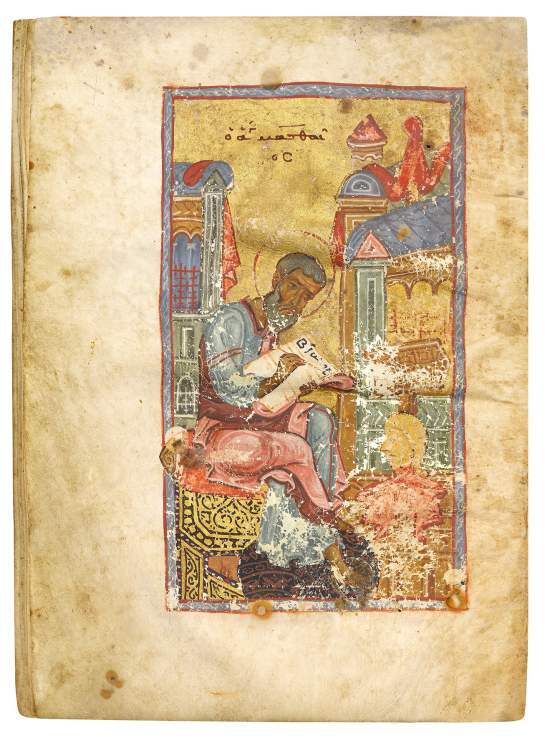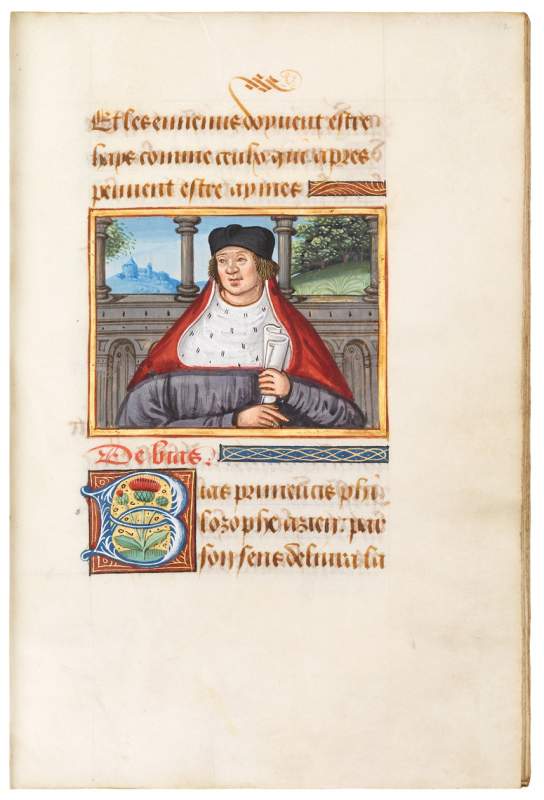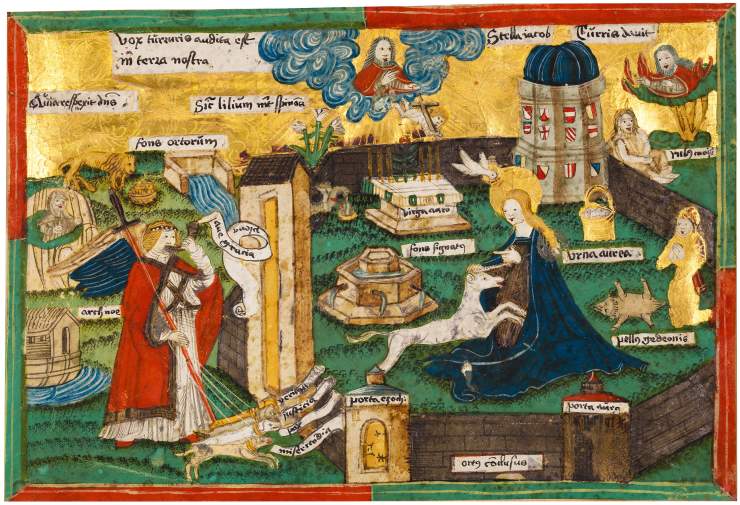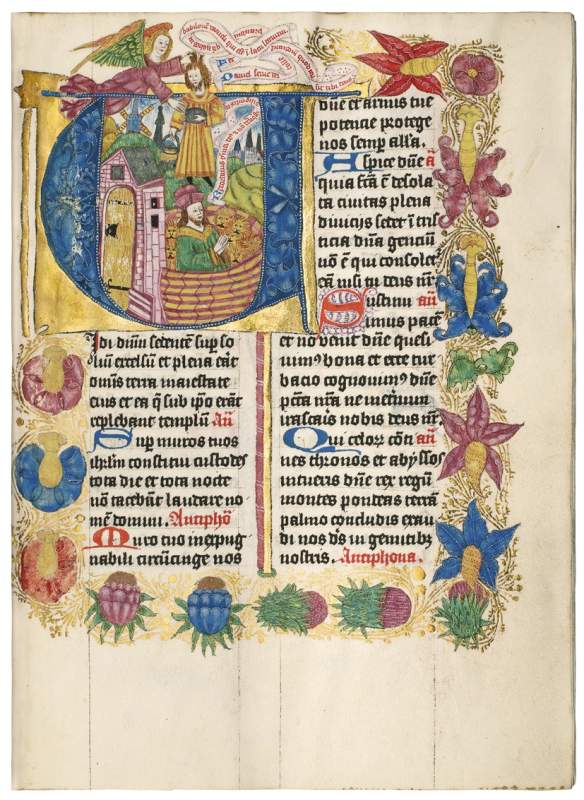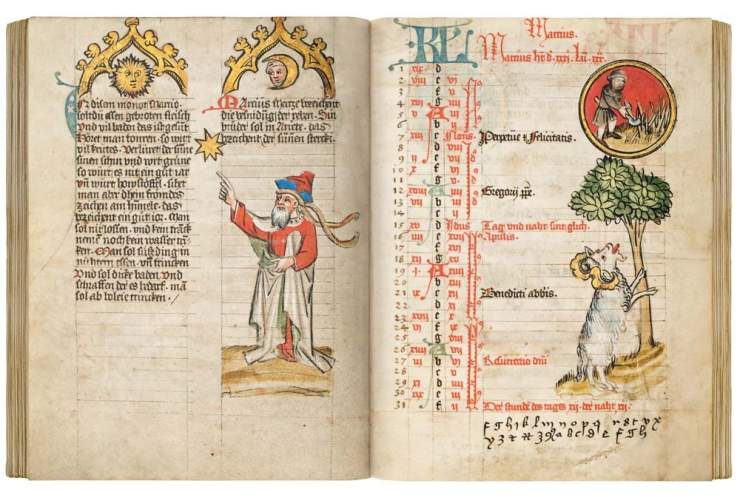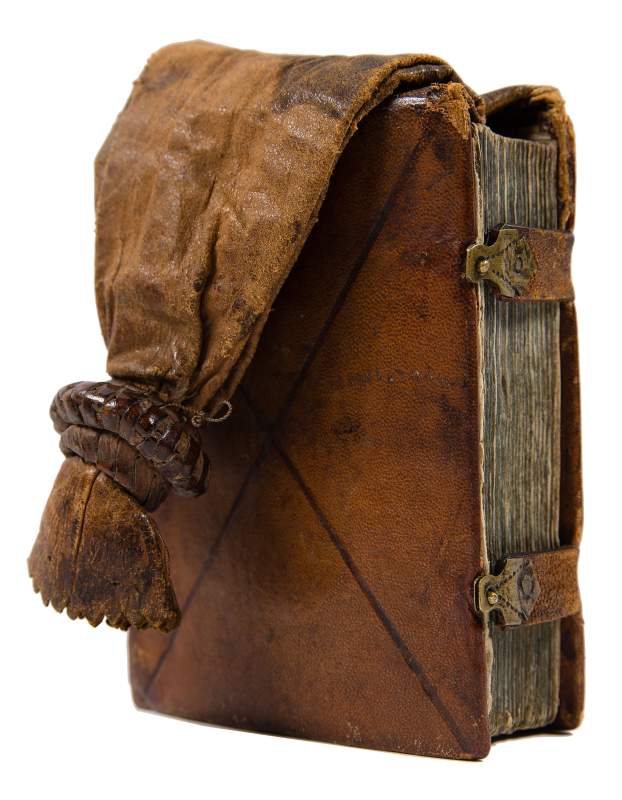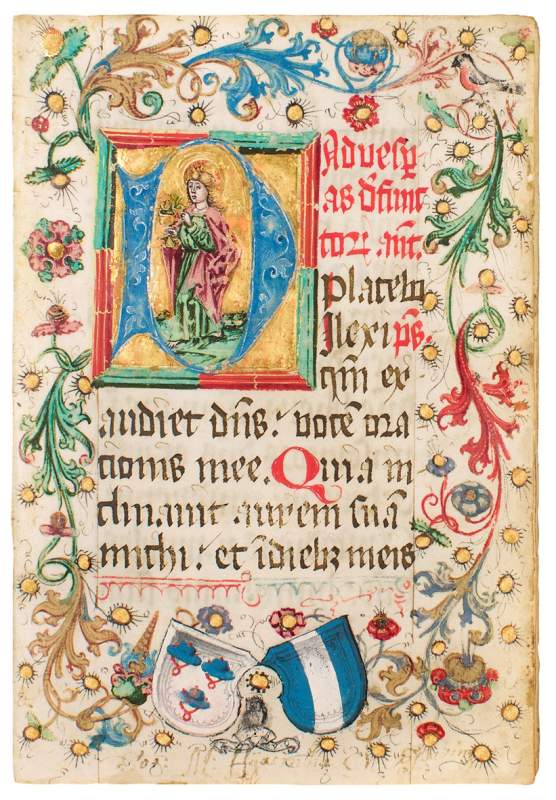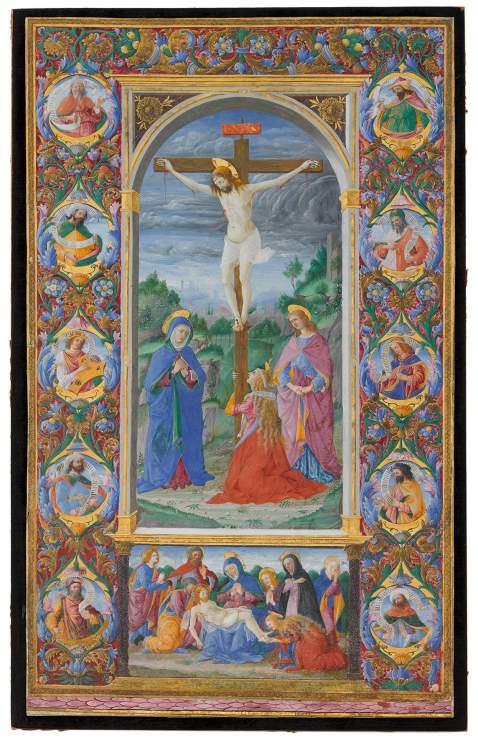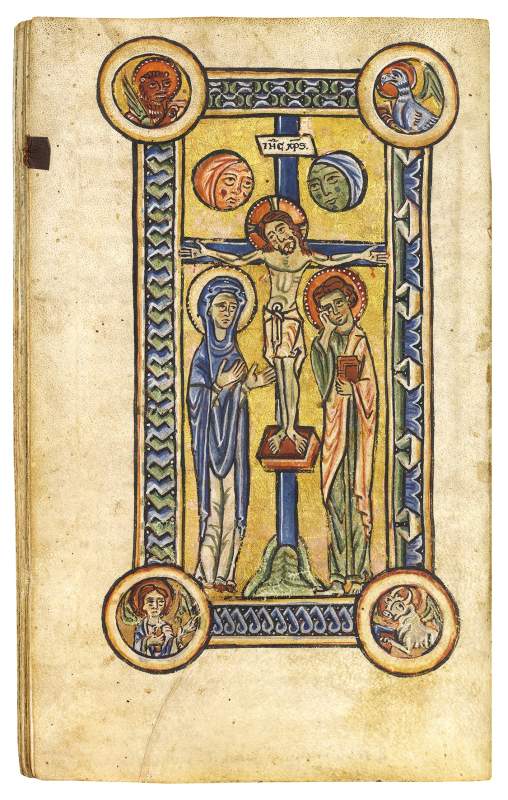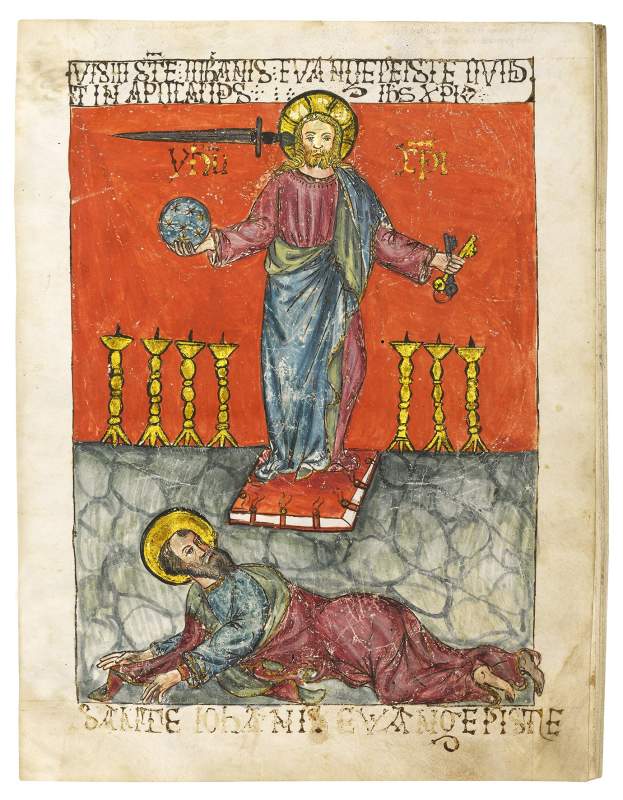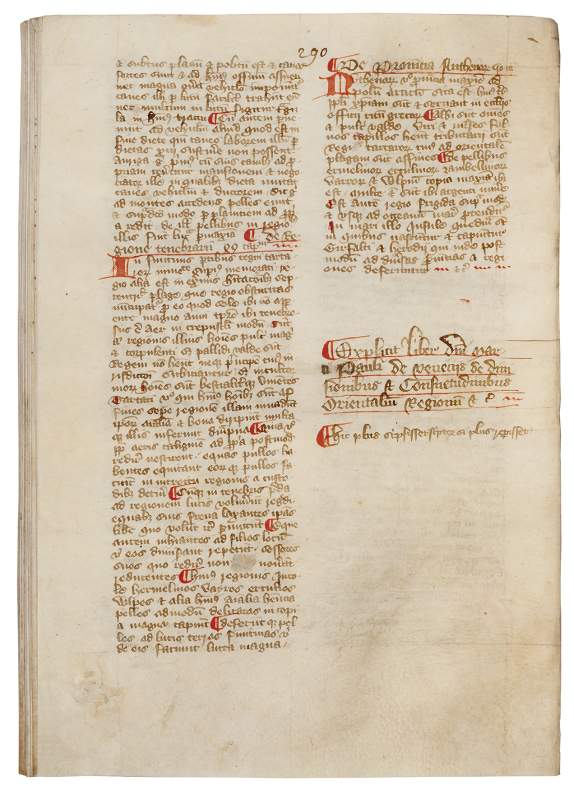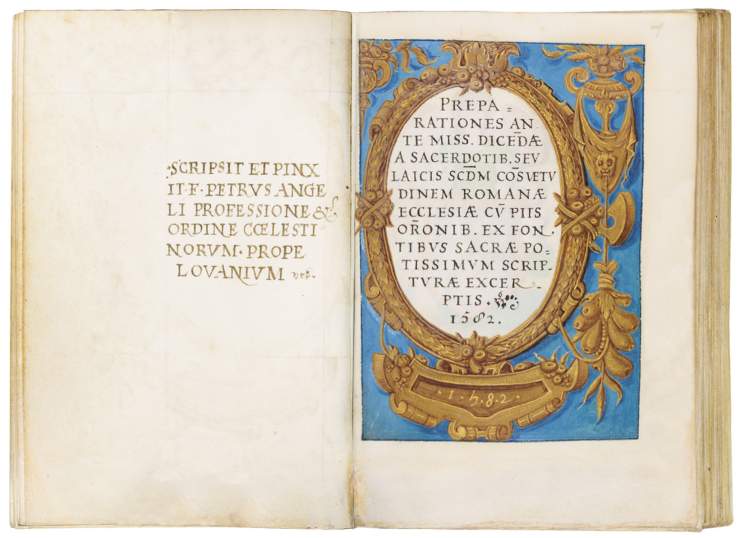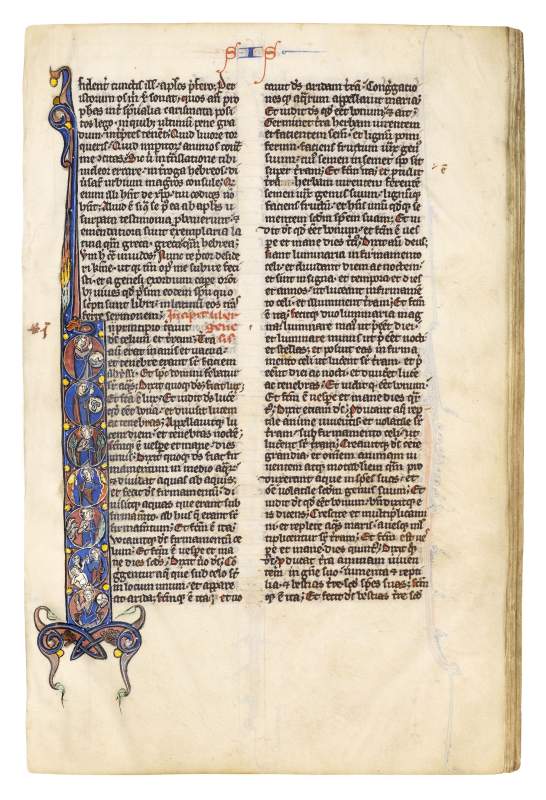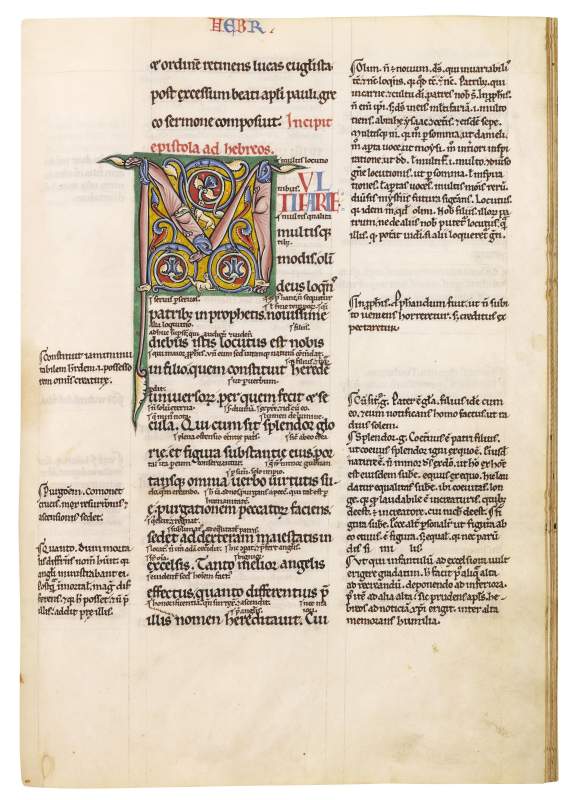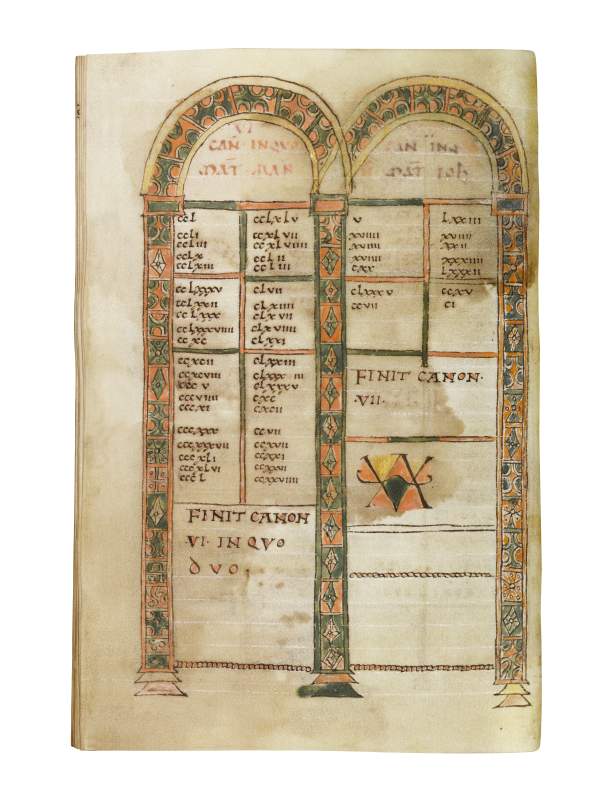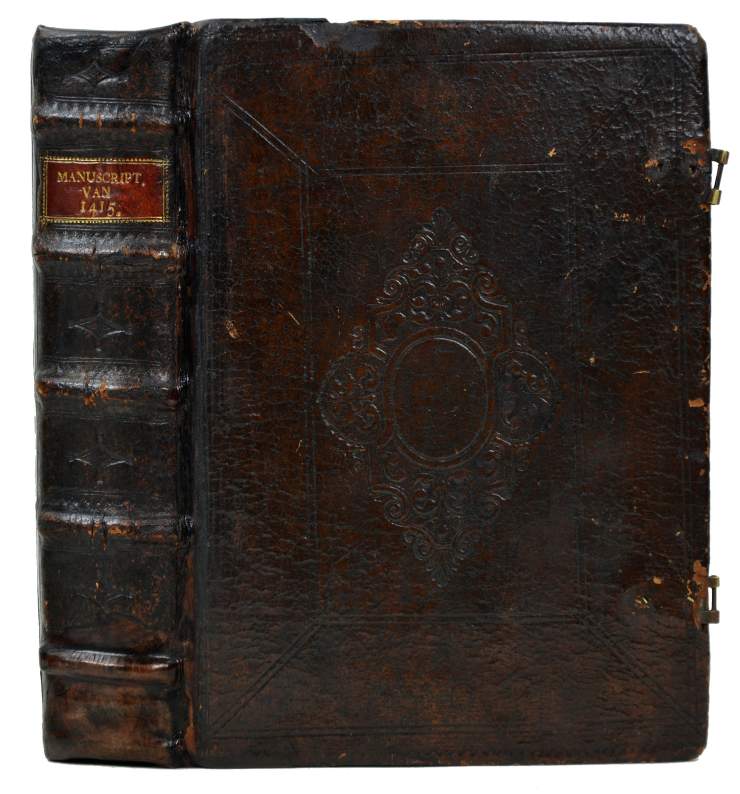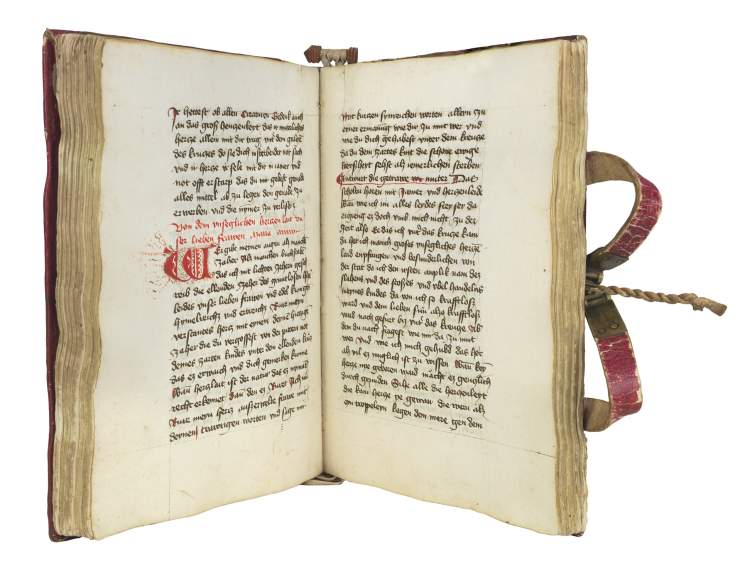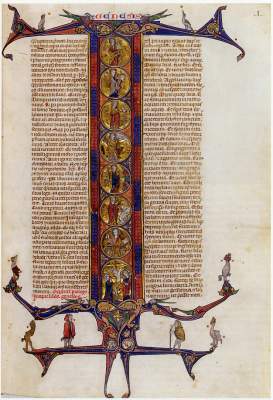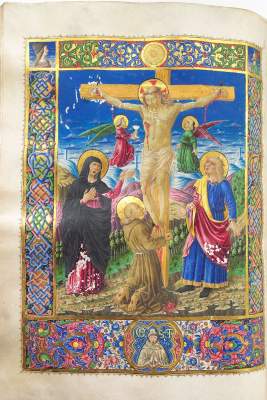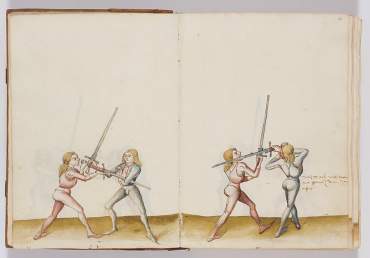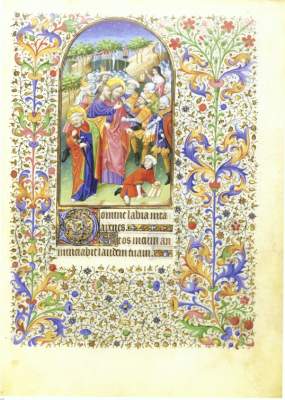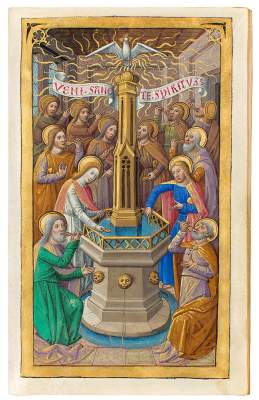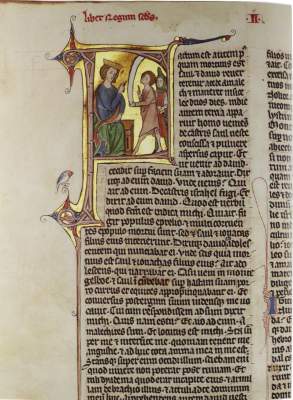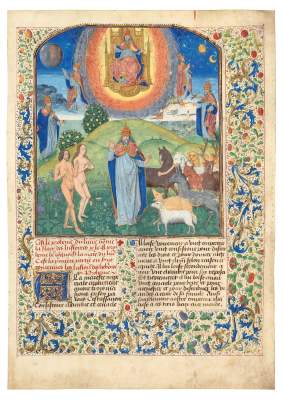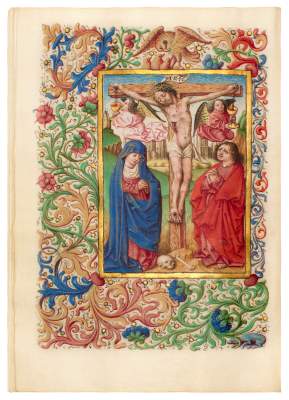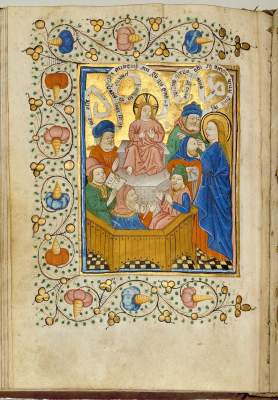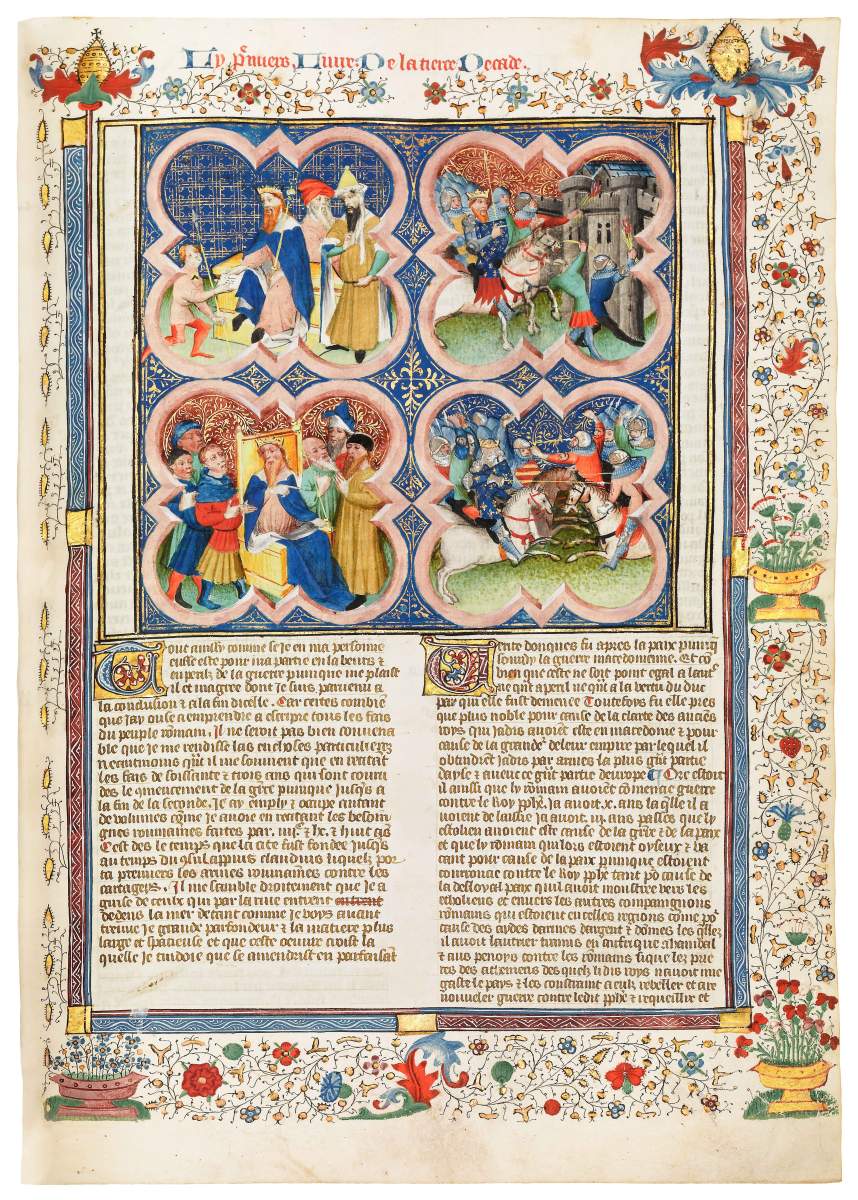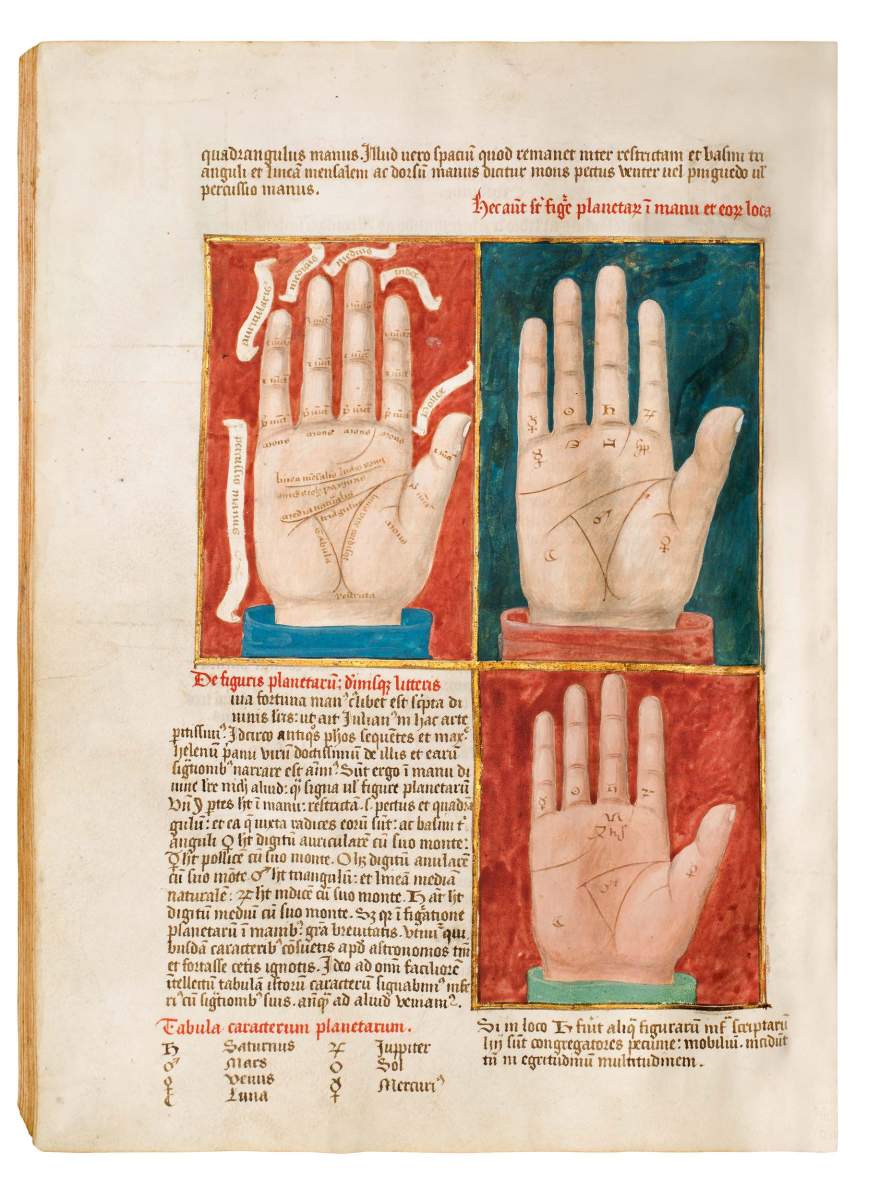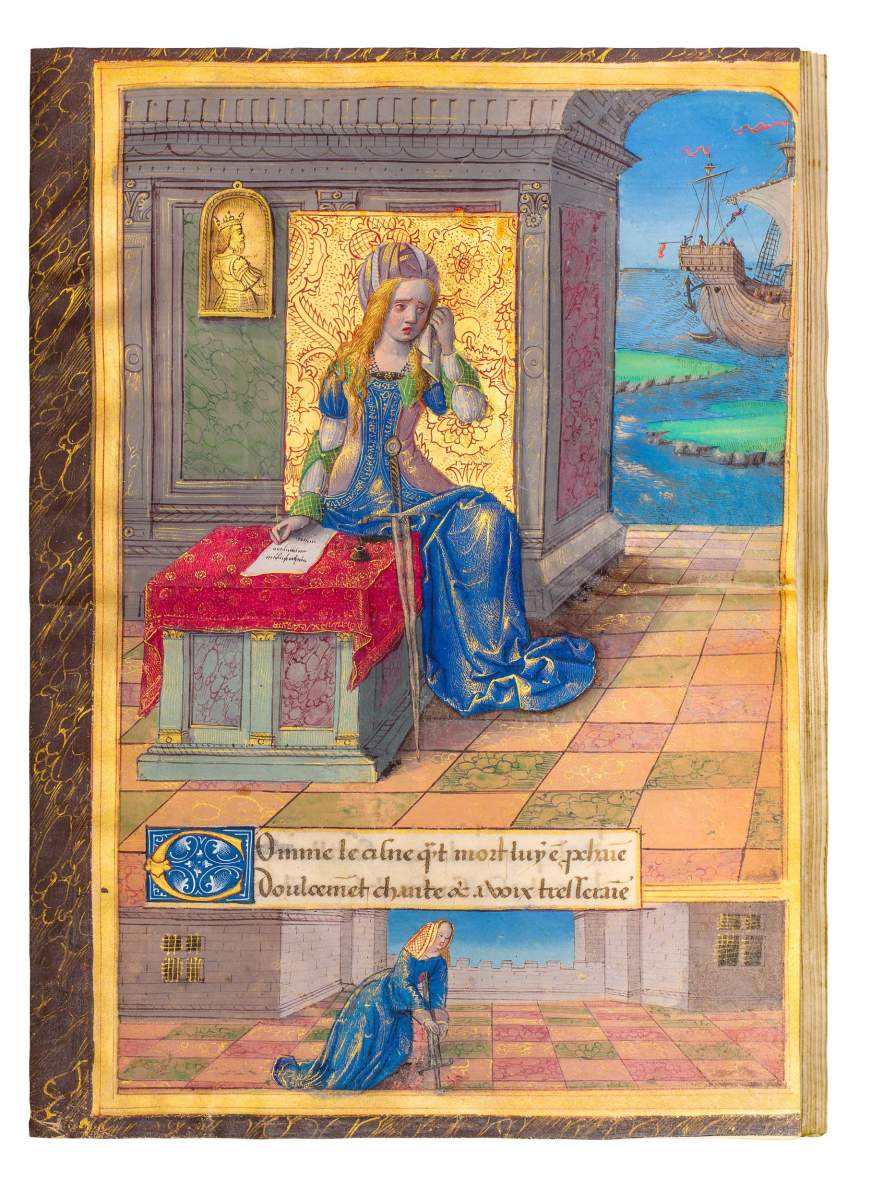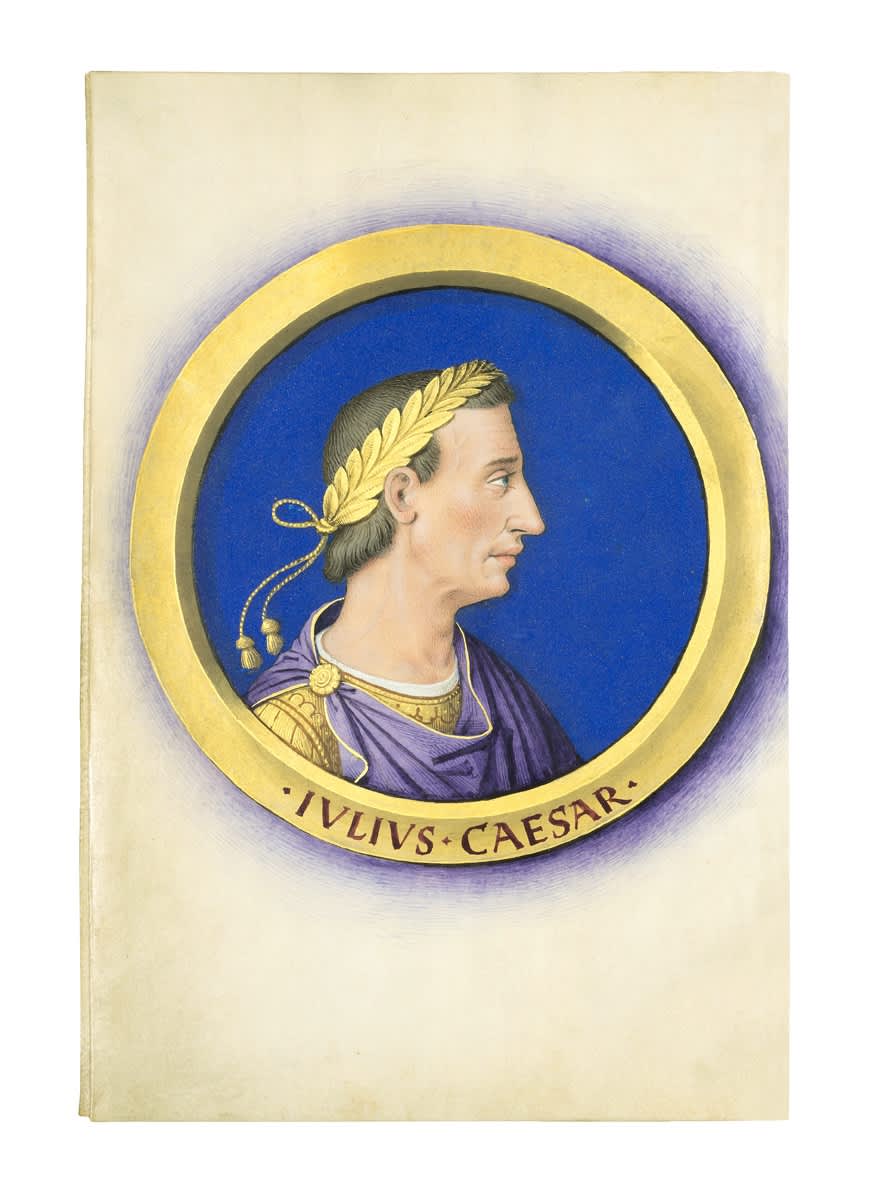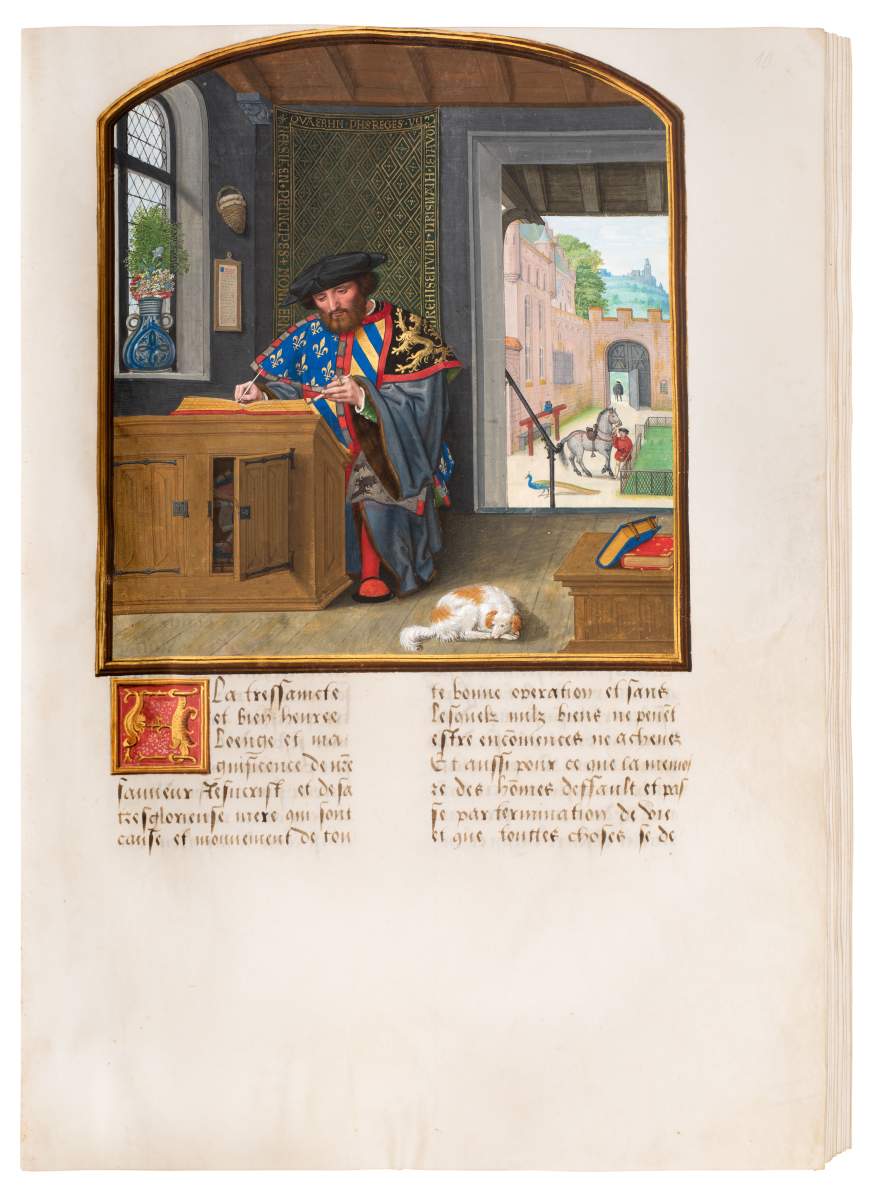Wir hatten öfter die Ehre, prachtvolle Bücher an die bedeutendsten Museen und Bibliotheken der Welt zu verkaufen. Jedes dieser Meisterwerke ist ein bleibendes Zeugnis für die Grossartigkeit ihrer Schöpfer.
Description of the Twelve Ceasars
Jean Bourdichon, Frankreich, Tours, um 1520Illuminierte Handschrift auf Pergament. 216 x 144 mm. – 34 Blätter, mit 16 ganzseitigen Miniaturen der Kaiser.
Die Description des douze cesars war fast ein Jahrhundert nicht in der Öffentlichkeit zu sehen. Sie gilt als eines der späten Meisterwerke des berühmten Hofmalers und Illuminators Jean Bourdichon (1457-1521), der die Handschrift wohl in den letzten Jahren seines Lebens schuf, im Auftrag seines letzten Förderes, König Francis I. von Frankreich.
Derzeit in der Bibliothèque nationale de France, ms. NAF 28800.
Tribute to the Bishop of Cuba
Acquired by Musea Brugge and Openbare Bibliotheek BruggeObsequiale for Jan de Witte, first Bishop of Santiago de Cuba, (Arenberg Ms. 35),
Manuscript in Latin on vellum with a full-page miniature and two full borders146 x 96 mm. 24 leavesThis wonderful manuscript is now in the possession of the Musea Brugge and Openbare Bibliotheek Brugge.
Read more about this fantastic work in our brochure, Collecting Culture.
Palmistry, Philosophy, and Precious Gems: created for Raphael de Mercatellis
Jean d’Outremeuse, I. Le tresorier de philosophie naturelle des pierres precieuses. – II. Ex divina philosophorum achademia secundum nature vires ad extra chyromanticie diligentissime collectum.manuscript in French and Latin written on vellum, with fourI: one historiated initial with the Mercatellis coat-of-arms, and two illuminated initials, II: 2 illuminated initials and 21 coloured drawings of hands in text and margins, ending with full-page motto L.Y.S. – III: 4 full-page miniatures
Raphael de Mercatellis (1437-1508) – a natural son of the Duke of Burgundy – was one of the most important Renaissance bibliophiles of the Low Countries. The recovery of this long-lost composite codex (dated 1484) adds much to our knowledge of the abbot’s interests and personality. In all details, this codex is a splendid contribution to the cultural history of the Southern Netherlands and that of European book culture in general.
Livy's History of Rome: Les Décades, illuminated for Jean III de Vy, chevalier
Manuscript on vellum, illuminated by Henri d’Orquevaulx with his self-portrait, a portrait of the scribe Jeannin de Rouen, and of the patron Jean III de Vy (d. 1449). France, Metz, dated 1440.With its 87 miniatures, this manuscript is one of the most profusely illustrated of all known copies of Livy’s History of Rome. Moreover, this unique codex offers the names of the scribe, the illuminator, and the commissioner: Maistre Jeannin from Rouen wrote it, while Henri d’Orquevaulx painted the illustrations for Jean III de Vy, chevalier.
Emperor Maximilian I's Theuerdank
edited by Melchior Pfintzing. “Nürnberg” [Augsburg]: Johann Schönsperger, 1 March 1517. First edition.With xylographic title and 118 woodcuts by Leonhard Beck, Hans Schäufelein, Hans Burgkmair and others.
The first edition of this masterpiece of woodcut illustration and typography a magnifcent copy printed on vellum embellished with luxury colouring. The Theuerdank (Noble Mind) is an epic poem that celebrates the exploits and heroic deeds of Emperor Maximilian (1459-1519; Emperor since 1508).
In this allegorical account the emperor is represented as Theuerdank who overcomes the difficulties of his journey to win his bride, Queen Ernreich, that is, Mary of Burgundy (1457-82, the daughter of Charles the Bold), who had married Maximilian in 1477.
Compendium made for Juan II, King of Castile and Leon
Illuminated manuscript in Latin on vellum. Spain, Castile, c. 1425With one 15-line historiated initial with painted border decoration over 3 margins, one decorated border with figures. A total of seven full-page illuminated leaves: 3 full-page miniatures, 1 armorial page, full-page figures of: celestial spheres, a map of the known world, and computational circles of movements of sun and moon, followed by tables.
Sensational new discovery of a compendium of King Juan II of Castile and Leon (1405-1454) including a combination of educational texts made for the young king. It was presumably created in or shortly after the nineteenth year of his reign, c. 1425. Perhaps it was intended for the heir as well, Enrique IV, born in 1425. With its creative miniatures portraying the craft of kingship and an unknown, provocative map of the world, it would serve as a incredibly helpful guide to leading a kingdom.
Hans Ebran von Wildenberg: Two Important Bavarian Chronicles
With: Andreas von Regensburg, Croniken von den Fürsten aus Bairn. Manuscript in German on paper with coats of arms and genealogical table of the Dukes of Bavaria. Germany, Bavaria, c. 1550-before 1553.This codex is bound in an exquisite Ottheinrich binding datable 1553 and comprises two important Bavarian Chronicles. The first of these was originally written for a member of the Wittelsbach House – presumably George the Rich, Ottheinrich’s grandfather. As only three other manuscripts of Hans Ebran’s Chronik are known, the present witness, which not yet been thoroughly analysed, is all the more important. The second text is a chronicle about the sovereigns of Bavaria. Both manuscripts are demonstrations of Bavarian power and self-imagining in this era – which may have been one reason why the present codex was not sent to Rome in 1622 with the rest of the Palatine Library. The direct relationship of both the fine binding and the texts to the Wittelsbach House make this book into a most fascinating 16th-century document.
Valturio's Famous Illustrated Military Treatise in the Vernacular
Robertus Valturius, (De re militari, in Italian) Opera de facti e praecepti militari. Verona: Boninus de Boninis, 17 February 1483. First edition in Italian.The first edition in Italian of this important work on war-craft, this is the first technical treatise in the vernacular. Roberto Valturio (born in Rimini, 1413-1484) was Apostolic secretary of pope Eugene IV, later he became secretary and adviser of Sigismondo Pandolfo Malatesta, ruler of Rimini (1417- 1468). Valturio composed De re militari on behalf of Malatesta probably between 1455 and 1460, in the midst of the military transition from siege-technology to gunpowder. His twelve books on warfare and military technique, however, concentrate on ancient and medieval weapons and strategies, which were still common in the 15th century
Epistres d'Ovide, of Queen Anne de Bretagne
France, Paris, Octovien de Saint-Gelais and the Master of the Chronique ScandaleuseIlluminated manuscript on vellum, in French, 265 x 190 mm. – 59 leaves. With 8 full-page compositions, some with pictorial borders.
This stunningly beautiful manuscript was made for Anne of Brittany, Queen of France. The compilation includes French translations of Ovid's epistolary poems and three French poems that were written for a highly exclusive audience.
Book of Flower Studies
Master of Claude de France, France, Tours, c. 1520Miraculously, this exceptional flower model book has survived in almost mint condition, raising the question whether this book was really meant as a model book or whether it was originally part of a larger collection of botanical paintings. Herbal or plant books from this period are exceedingly rare.
This work is now in the collection of the Metropolitan Museum of Art in New York City.
Livre des faits du bon chevalier Jacques de Lalaing
Flandern, Brügge, geschrieben in den 1480ern, Simon Bening und Werkstatt um 1520.Illuminierte Handschrift auf Pergament, französisch. 364 x 262 mm. – 202 Blätter, mit 18 Miniaturen.
Mit der erlesenen Illumination von Brügges besten Buchmalern ist dieser Kodex eine Ode an den Bon Chevalier Jacques de Lalaing, Herold des Ordens vom Goldenen Vlies, und and die ritterliche Gesellschaft. Heldentaten, schöne Kleider, herrliche Pferde, aussergewöhnliche Landschaften und ein grossartiges Autorenporträt offenbaren die Pracht burgundischer Bibliophilie. Illuminiert wurde das Buch wahrscheinlich für Charles I., seigneur de Lalaing († 1525).
Derzeit im J. Paul Getty Museum, ms. 114.
Stammheimer Missale
DEUTSCHLAND, HILDESHEIM, UM 1170-1180Illuminierte Handschrift auf Pergament. 285 x 190 mm. – 184 Blätter mit 14 ganzseitigen Miniaturen, einer ganzseitigen Schmuckinitiale, 46 großen historisierten Initialen und über 100 zwei-dreizeiligen Initialen.Das Stammheimer Missale ist ein eindrucksvolles Meisterstück aus der Romanik, das in der Benediktinerabtei von St. Michael in Hildesheim geschaffen wurde. Die kraftvolle künstlerische Tradition, die auf den heiligen Bischof Bernward, den Gründer des Klosters (996) zurückgeht, wird in der lebhaften romanischen Buchmalerei dieser Handschrift deutlich und bezeugt das hohe Ansehen einer der bedeutendsten deutschen Abteien des Mittelalters.
Dieses Werk ist jetzt in der Sammlung des J. Paul Getty Museum in Los Angeles.
Abbildung mit freundlicher Genehmigung des J. Paul Getty Museums.
Miniaturstundenbuch, Gebrauch von Rom
Flandern, Brügge, Simon Bening, um 1530-1535.Illuminierte Handschrift auf Pergament. 59 x 42 mm. – 216 Blätter, mit 12 Kalenderminiaturen, 22 ganzseitigen Miniaturen und 23 vierseitigen Bordüren im Gent-Brügger Stil.
Dieses ausserordentliche Gebetbuch, quasi ein Schmuckstück, stammt von einem der berühmtesten Buchmaler Europas, Simon Bening. Die Miniaturen dieses Stundenbuchs sind von höchster Qualität: unglaublich detailliert, ergreifend, atmosphärisch und in Benings ausgefeiltester Technik gemalt.
Derzeit im Metropolitan Museum of Art, The Cloisters Collection, 2015.706.
Gebetbuch für den jungen Karl V. – mit seinem vorkaiserlichen Wappen
Mitarbeiter Simon Benings, Flandern, Brügge (?), um 1516-1517.Illuminierte Handschrift auf Pergament, lateinisch. 172 x 120 mm. – 38 Blätter, 36 Seiten mit Buchmalerei, darunter ein ganzseitiges Wappen und 31 Miniaturen.
Dieses Buch von kleinem Format, aber fast auf jeder Seite mit einer Miniatur, ist ein faszinierender Zeuge flämischer Kultur des frühen 16. Jahrhunderts. Es ist wohl das früheste erhaltene Gebetbuch, das für Karl V. geschaffen wurde, als Geschenk oder in seinem Auftrag. Es ist auch eine der ersten Handschriften, die Elemente der Nordischen Renaissance enthalten. Die ungewöhnliche Ikonographie deutet auf Traditionen in Brügge – wo Karls feierlicher Einzug im April 1515 stattfand.
Derzeit im Museum of the Bible.
Wedding Hours made for Bianca Maria Sforza and Maximilian I
MASTER OF ANNA SFORZA, ITALY, MILAN, 1493Illuminated manuscript on vellum98 x 70 mm. 235 leaves. With 15 full-page miniatures, 14 of which are accompanied by an elaborately decorated text-page with full, historiated borders.The Wedding Hours is a highly important work of cultural heritage and is of exceptional historical and art-historical value. This manuscript is the long-lost wedding gift created for Bianca Maria Sforza (1472-1510) upon her marriage to the Holy Roman Emperor elect, Maximilian I of Austria-Habsburg. The book was commissioned by the noblewoman’s uncle, Ludovico ‘Il Moro’ Sforza and not only testifies to the high level of Renaissance art made for the Sforza family in Milan, but also shows how art was used to link social, religious, and political life.
The Book of Joshua – Fragment from the Gutenberg Bible
Mainz, Johannes Gutenberg and Johannes Fust, c. 1454Incunable – Rubricated, headlines, chapter numbers and Lombard initials supplied in alternating red and blue letters, versals touched in red. Two initials cut, restored in facsimile, missing text and initials replaced. 391 x 290 mm.
The present 13 continuous paper leaves comprise the complete Book of Joshua from a copy of the first printed Bible, volume I, fol. 102-114.
St. Aldhelm of Malmsbury, De Laude Virginitatis
SOUTHERN ENGLAND, PROBABLY GLASTONBURY OR WORCESTER, C. 800The decorated manuscript in Latin was made in Southern England, probably Glastonbury or Worcester, around 800. It is an exceedingly rare example of early English script and a contemporary of the renowned Book of Kells. The manuscript at hand is a bifolium from the oldest, most important, extant manuscript of a text by the earliest major English author, St. Aldhelm of Malmsbury. It additionally includes fascinating glosses in the Anglo-Saxon language. The original manuscript was potentially owned by St. Dunstan (c. 910-88), the royal court scholar of King Edgar. The manuscript was taken apart hundreds of years ago.
Evangeliar mit Kephalaia, und andere Texte
Geschrieben von Manuel Hagiostephanites für Johannes von Kreta, Zypern, 1156Illuminierte Handschrift auf Pergament und Papier, griechisch. 224 x 162 mm. – 342 (Pergament-) + 11 (Papier-) Blätter mit 4 grossen Initialen (1 historisiert), 4 halbseitigen und 4 ganzseitigen Miniaturen.
Im Auftrag von Johannes dem Kreter, Erzbischof von Zypern von 1152-1177, wurde diese Handschrift von dem Schreiber Manuel Hagiostephanites kopiert. Das Buch war im Juli A.M. 6664 (= 1156 n. Chr.) vollendet, wie der Schreiber im Kolophon auf fol. 340v vermerkt hat.
Derzeit im der Sammlung des Museum of the Bible.
McKell Medical Almanac
DIEBOLD LAUBER WORKSHOP, ALSACE, HAGENAU, C. 1445Illuminated manuscript on paper.206 x 155 mm. – 12 leaves, of which 11 illuminated, including 12 occupations of the month, and 11 half-page depictions of astronomers.An almanac offers astronomical-medical information arranged according to the calendar of the year. Often worn by intense use, these booklets are extremely rare. This is an extraordinary copy, finely illuminated in colours and gold in the workshop of the celebrated Diebold Lauber, made for a patron in the diocese of Strasbourg.This work is now in the collection of the Bibliothèque nationale et universitaire in Strasbourg, Ms. 7. 141.Kreuzigung mit Beweinungsszene, umgeben von König David und Propheten
Giuliano Amadei, Italien, Rom, 1489Ganzseitige Miniatur mit reichem Bordürenschmuck. 397 x 242 mm.
Dieses prächtig illuminierte Blatt gehörte einst zum Missale des Papstes Innozenz VIII., das in der Sixtinischen Kapelle aufbewahrt wurde. Diese Kreuzigung leitete zweifellos das Hochgebet, Canon Missae, ein und war daher die kostbarste Miniatur in diesem päpstlichen Messbuch.
Derzeit im J. Paul Getty Museum, ms. 110.

